Joan Bennett (1910–1990) was an American actress who had her breakthrough in Little Women (George Cukor, 1933). Producer Walter Wanger helped to manage her career and eventually married her in 1940. At the beginning of the 1940s, Bennett appeared in three classic Film Noirs by Fritz Lang. These turned her into an iconic femme fatale of the Film Noir.

Italian postcard by Garami, Milano, no. 154. Photo: RKO Radio Films. Joan Bennett in The Woman in the Window (Fritz Lang, 1944).

German collectors card in the Moderne Schönheitsgalerie by Ross Verlag for Kurmark cigarettes, no. 151 of 300. Photo: Fox.
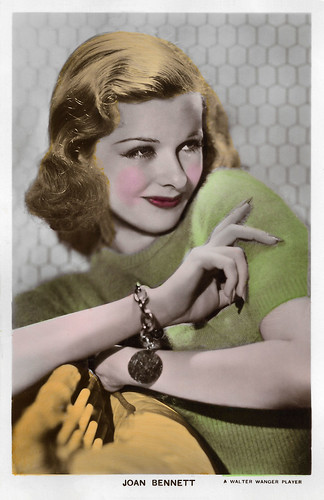
British postcard in the Colourgraph Series, London, no. C 112a. Photo: Walter Wanger.

French postcard, no. 648. Photo: Paramount.

Belgian collectors card. Photo: Columbia.
In 1910, Joan Geraldine Bennett was born in Palisades Park (other sources say Fort Lee) in New Jersey as the youngest of the three daughters of stage actors Richard Bennett and Adrienne Morrison. Her two older sisters were Constance Bennett, who later also became an actress, and Barbara Bennett.
Bennett started her career as an actress when she was a child. At the age of four, Joan made her first stage appearance. She debuted in the cinema a year later in the silent film The Valley of Decision (Rae Berger, 1916), in which her father was the star and the entire Bennett clan participated. In 1923 she again appeared in a film which starred her father, playing a pageboy in The Eternal City (George Fitzmaurice, 1923). It would be five more years before Joan appeared again on the screen.
In 1926, at the age of 16, she married John Marion Fox, who was 26. The union was anything but happy, in great part because of Fox's heavy drinking. In February of 1928, Joan and Jack had a baby girl they named Adrienne Ralston Fox (later Diana Markey). The new arrival did little to help the marriage, though, and in the summer of 1928, they divorced.
Now with a baby to support, Joan did something she had no intention of doing - she turned to acting. At the age of 18, she was debuting on Broadway in her father's play 'Jarnegan'. She also appeared in the silent film Power (Howard Higgin, 1928) with Alan Hale and Carole Lombard, a small role but a start.
At age 19 she had her first important film roles in the early talkies Bulldog Drummond (F. Richard Jones, 1929), starring Ronald Colman, and Disraeli (Alfred E. Green, 1929), starring George Arliss. Not only did audiences like her, but so did the critics.
Bennett had easily made the passage to sound cinema and starred e.d. in the United Artists musical Puttin' on the Ritz (Edward Sloman, 1930). She got a contract with Fox and was featured in films as the blonde girl in e.g. She Wanted a Millionaire (John G. Blystone, 1932) opposite Spencer Tracy, and Me and My Gal (Raoul Walsh, 1932) as a wisecracking waterfront waitress, again opposite Tracy.
She left Fox in 1933 to act in the RKO film Little Women (George Cukor, 1933), as pert sister Amy opposite Katharine Hepburn as Jo. Bennett struggled hard to hold on because she was not taken seriously. In addition, she was often compared negatively to her sister Constance Bennett, who had since become a superstar.
In 1932 she married screenwriter and film producer Gene Markey and had one daughter with him, Melinda, but they divorced in 1937.

German postcard by Ross Verlag, no. 4780/1, 1929-1930. Photo: United Artists. Ronald Colman and Joan Bennett in Bulldog Drummond (F. Richard Jones, 1929).
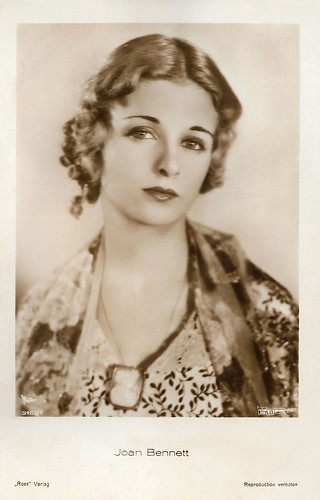
German postcard by Ross Verlag, no. 5461/1, 1930-1931. Photo: National / Warner Bros / Vitaphone.

Dutch postcard by the Rialto Theatre, Amsterdam, 1934. Photo: Remaco Radio Picture. Publicity still for Little Women (George Cukor, 1933). In the picture are Katharine Hepburn, Joan Bennett, Frances Dee, Jean Parker, and Spring Byington. The Dutch title of the film and the book by Louise M. Alcott is Onder moeders vleugels.
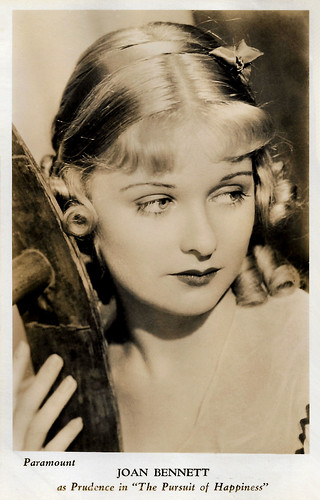
British postcard Photo: Paramount. Joan Bennett as Prudence in The Pursuit of Happiness (Alexander Hall, 1934).

British postcard in the Picturegoer Series, London, no. 437a.
Little Women brought Joan Bennett to the attention of independent producer Walter Wanger. She signed a personal contract with him and he managed her career from then on. They eventually married in 1940. Together with director Tay Garnett, Wanger managed to persuade Bennett to dye her hair brown for Trade Winds (Tay Garnett, 1938), the seemingly trivial change drastically altered her screen image from insipid ingénue to smoldering temptress.
She was subsequently staged in films as 'the seductive woman' and received more attention. During the search for the role of Scarlett O'Hara in Gone with the Wind (Victor Fleming, 1939), Bennett was tested and left a good impression on producer David O. Selznick. Bennett seemed to get the role, but Selznick later became more interested in Paulette Goddard, who would eventually be replaced by Vivien Leigh.

Italian postcard by Garami, Milano, no. 154. Photo: RKO Radio Films. Joan Bennett in The Woman in the Window (Fritz Lang, 1944).

German collectors card in the Moderne Schönheitsgalerie by Ross Verlag for Kurmark cigarettes, no. 151 of 300. Photo: Fox.

British postcard in the Colourgraph Series, London, no. C 112a. Photo: Walter Wanger.

French postcard, no. 648. Photo: Paramount.

Belgian collectors card. Photo: Columbia.
Struggling hard to hold on
In 1910, Joan Geraldine Bennett was born in Palisades Park (other sources say Fort Lee) in New Jersey as the youngest of the three daughters of stage actors Richard Bennett and Adrienne Morrison. Her two older sisters were Constance Bennett, who later also became an actress, and Barbara Bennett.
Bennett started her career as an actress when she was a child. At the age of four, Joan made her first stage appearance. She debuted in the cinema a year later in the silent film The Valley of Decision (Rae Berger, 1916), in which her father was the star and the entire Bennett clan participated. In 1923 she again appeared in a film which starred her father, playing a pageboy in The Eternal City (George Fitzmaurice, 1923). It would be five more years before Joan appeared again on the screen.
In 1926, at the age of 16, she married John Marion Fox, who was 26. The union was anything but happy, in great part because of Fox's heavy drinking. In February of 1928, Joan and Jack had a baby girl they named Adrienne Ralston Fox (later Diana Markey). The new arrival did little to help the marriage, though, and in the summer of 1928, they divorced.
Now with a baby to support, Joan did something she had no intention of doing - she turned to acting. At the age of 18, she was debuting on Broadway in her father's play 'Jarnegan'. She also appeared in the silent film Power (Howard Higgin, 1928) with Alan Hale and Carole Lombard, a small role but a start.
At age 19 she had her first important film roles in the early talkies Bulldog Drummond (F. Richard Jones, 1929), starring Ronald Colman, and Disraeli (Alfred E. Green, 1929), starring George Arliss. Not only did audiences like her, but so did the critics.
Bennett had easily made the passage to sound cinema and starred e.d. in the United Artists musical Puttin' on the Ritz (Edward Sloman, 1930). She got a contract with Fox and was featured in films as the blonde girl in e.g. She Wanted a Millionaire (John G. Blystone, 1932) opposite Spencer Tracy, and Me and My Gal (Raoul Walsh, 1932) as a wisecracking waterfront waitress, again opposite Tracy.
She left Fox in 1933 to act in the RKO film Little Women (George Cukor, 1933), as pert sister Amy opposite Katharine Hepburn as Jo. Bennett struggled hard to hold on because she was not taken seriously. In addition, she was often compared negatively to her sister Constance Bennett, who had since become a superstar.
In 1932 she married screenwriter and film producer Gene Markey and had one daughter with him, Melinda, but they divorced in 1937.

German postcard by Ross Verlag, no. 4780/1, 1929-1930. Photo: United Artists. Ronald Colman and Joan Bennett in Bulldog Drummond (F. Richard Jones, 1929).

German postcard by Ross Verlag, no. 5461/1, 1930-1931. Photo: National / Warner Bros / Vitaphone.

Dutch postcard by the Rialto Theatre, Amsterdam, 1934. Photo: Remaco Radio Picture. Publicity still for Little Women (George Cukor, 1933). In the picture are Katharine Hepburn, Joan Bennett, Frances Dee, Jean Parker, and Spring Byington. The Dutch title of the film and the book by Louise M. Alcott is Onder moeders vleugels.

British postcard Photo: Paramount. Joan Bennett as Prudence in The Pursuit of Happiness (Alexander Hall, 1934).

British postcard in the Picturegoer Series, London, no. 437a.
The femme fatale of Fritz Lang's Film Noirs
Little Women brought Joan Bennett to the attention of independent producer Walter Wanger. She signed a personal contract with him and he managed her career from then on. They eventually married in 1940. Together with director Tay Garnett, Wanger managed to persuade Bennett to dye her hair brown for Trade Winds (Tay Garnett, 1938), the seemingly trivial change drastically altered her screen image from insipid ingénue to smoldering temptress.
She was subsequently staged in films as 'the seductive woman' and received more attention. During the search for the role of Scarlett O'Hara in Gone with the Wind (Victor Fleming, 1939), Bennett was tested and left a good impression on producer David O. Selznick. Bennett seemed to get the role, but Selznick later became more interested in Paulette Goddard, who would eventually be replaced by Vivien Leigh.
At the beginning of the 1940s, Bennett appeared in four films by Fritz Lang, possibly her finest films. Three of those films, Man Hunt (1941) with Walter Pidgeon, The Woman in the Window (1944) with Edward G. Robinson, and Scarlet Street (1945) again with Robinson, turned the now dark-haired Bennett into an iconic femme fatale of the Film Noir.
In addition, she has also appeared in Film Noirs by Jean Renoir, The Woman on the Beach (1947) with Robert Ryan, and by Max Ophüls, The Reckless Moment (1949), opposite James Mason.
Bennett also played the wife of Spencer Tracy and mother of Elizabeth Taylor in Father of the Bride (Vincente Minnelli, 1950) and the sequel, Father's Little Dividend (Vincente Minnelli, 1951).

British Real Photograph postcard, no. 154. Photo: Paramount Pictures.

British postcard in the Film Partners Series, London, no. P 264. Photo: Walter Wanger. Fredric March and Joan Bennett in Trade Winds (Tay Garnett, 1938).

German card. Photo: RKO Radio Films.
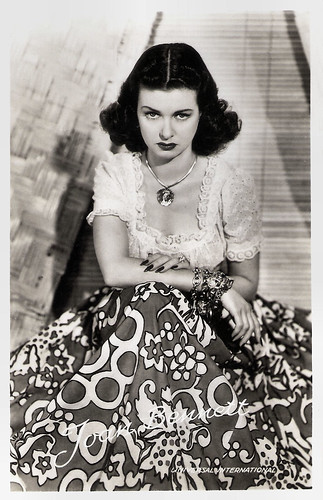
Belgian postcard, no. 3102. Photo: Universal International.
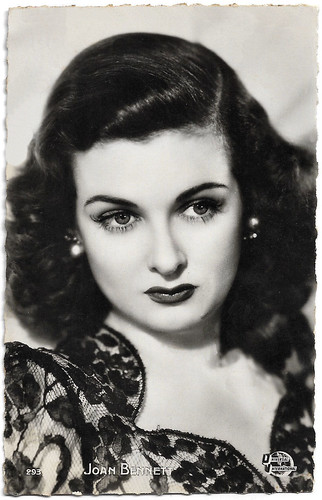
French postcard by Editions P.I., Paris, no. 293, offered in Belgium by S.A. Victoria, Brussels. Photo: Universal-International.
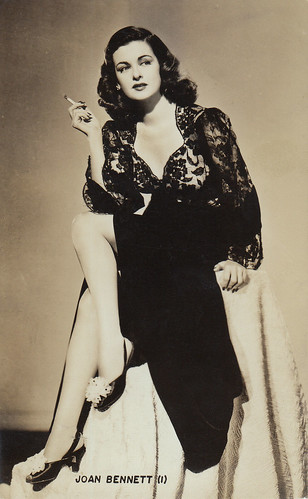
Vintage postcard. Joan Bennett in Scarlet Street (Fritz Lang, 1945). Collection: Marlene Pilaete.
The scandal that destroyed Bennett's film career
For 12 years, Joan Bennett had the same agent, Jennings Lang. In 1951, Walter Wanger shot Lang in the groin, presuming they had an affair. Lang did not die but sustained serious injuries. Wanger was convicted of attempted murder and served a four-month sentence.
It was considered a scandal and it destroyed Bennett's film career. Wanger got only four months of prison and moved out from Bennett, but remained married to her until 1965. From 1961 to 1964, Joan was romantically involved with actor John Emery and cared for him to the end of his final illness.
Bennett still managed to develop a successful career in theatre and television. From 1966 to 1971, she was featured in the television series Dark Shadows. She played the mother of the rich Collins family of Collinsport, Maine, which is tormented by strange occurrences. For this role, she was nominated for an Emmy Award.
She could still be seen in a few films, including Dario Argento's Suspiria (1977). In 1978 Bennett married David Wilde, a retired businessman and movie critic. Her final public performance was in the TV film Divorce Wars: A Love Story (Donald Wrye, 1982).
In 1990, Joan Bennett died of a heart attack in Scarsdale, NY, at the age of 80. For her work, she had a star on the Hollywood Walk of Fame. She had four daughters: Adrienne Ralston Fox (1928), Melinda Markey (1934), Stephanie Wanger (1943), and Shelley Wanger (1948). In 1970, Joan Bennett had published her memoir, 'The Bennett Playbill'.

British postcard in the Film Partners Series, London, no. P. 306. Photo: Edward Small Prod. Louis Hayward and Joan Bennett in The Man in the Iron Mask (James Whale, 1939).

British postcard in the Picturegoer Series, London, no. 1245a. Photo: Walter Wanger.

British postcard in the Picturegoer Series, London, no. W 323. Photo: United Artists.

Belgian postcard by Film en Toneel, no. AX 141. Photo: Columbia Pictures.

German postcard by Kunst und Bild, Berlin, no. A 129. Photo: Columbia.
Sources: Denny Jackson (IMDb), Wikipedia (English and Dutch), and IMDb.
No comments:
Post a Comment